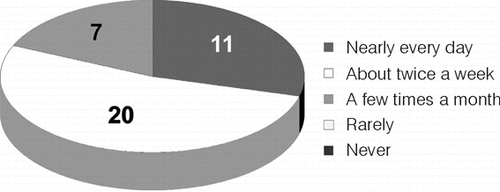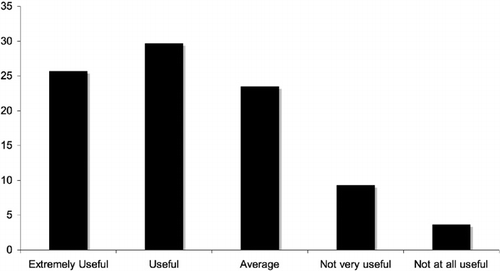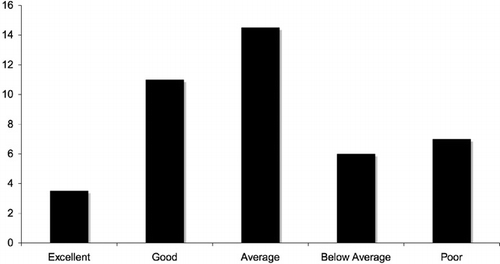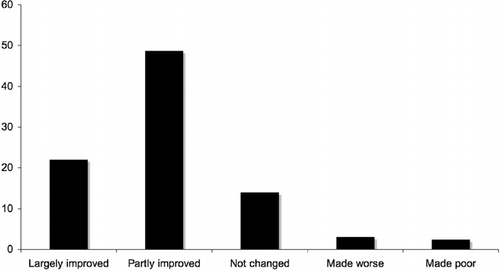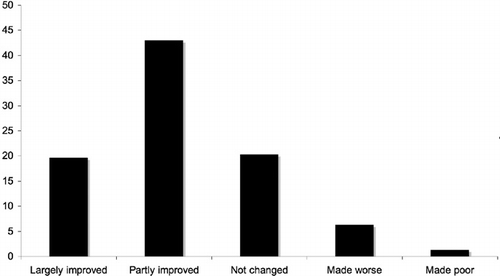Abstract
Ravensbourne College of Design and Communication is a design college with a small School of Broadcast Engineering embedded within the creative Faculty of Communication Media. The School offers a FdSc (Foundation Degree, Science) in Broadcast Media Technology and an associated BSc Broadcast Technology honours degree top-up. The vocational nature of these Engineering courses is highly regarded by the industry they serve and encourages a diverse student intake. Over the last three years a wide range of eTeaching and eLearning applications has been introduced to encourage maximum student engagement with the course and its content, whether students are in the college or off site. A college-wide Laptop Project allows all students to purchase a laptop and course-related software at heavily discounted prices. Students are actively encouraged to use their laptops during tutorials and seminars to reinforce and support their learning. The media-enriched Moodle VLE (virtual learning environment) is strongly integrated into the course delivery, assessment and feedback. Teaching staff all have an active online social networking presence and use podcasting and vodcasting to support, blend and enhance teaching activities. This case study describes the tutor and student experiences of integrating these new eTeaching and eLearning methodologies into our pedagogy. It reflects on how issues such as a wide range of learning styles, prior knowledge and subject-related experience and personal goals that arise from a more diverse cohort of students can be addressed by making learning practical, involving and fun. The success of this blended approach has led to the development of a new cluster of related Broadcast Engineering courses to delineate the student options for our vocational Foundation and Honours Engineering degree pathways.
Background
In addressing the needs of a diverse range of students on a highly practical vocational Engineering course, it has been natural to adopt and develop a blended approach to teaching and learning. While lectures can provide an effective method of transmitting information, there are better ways of stimulating students (CitationBligh, 2000). CitationYoon and Lim (2007) describe blended learning as ‘a purposeful mix of delivery media (particularly face-to-face and various forms of technologies) to improve learning/performance.’ They not only define blended learning technically, but also describe it as being concerned with the mix of people and their access to each other. At Ravensbourne College, the small Broadcast Engineering class size (between 15 and 25 students per year) lends itself perfectly to an interactive lecture approach for face-to-face teaching. Interactive lectures offer an enhanced learning experience, compared to the more traditional monologue and didactic lecture (CitationNortcliffe et al., 2003) where there is little chance for learners to confirm their understanding through questioning or for the teacher to assess it. Activity and interaction are powerful forces in undergraduate teaching (CitationChickering and Gamson, 1987). A combination of face-to-face lectures and a VLE has been reported to be the preferred learning environment for students (CitationSmailes, 1998 and CitationDavis et al., 2005), as the VLE will increase the ways in which they can encounter the subject, differentiating learners and encouraging deep discovery learning (CitationBruner, 1967).
The Broadcast Technology foundation degree course at Ravensbourne College has a relatively low minimum entry requirement (four GCSEs (A - C), including mathematics, and at least one A level (A - C) or equivalent), compared with many other Engineering courses where three A levels or equivalent (including mathematics) is a more common entry requirement (CitationNewman-Ford et al., 2007). All applicants meeting the minimum entry requirement are offered an interview at which the likelihood of them achieving the course learning outcomes is assessed. This encourages a wide range of applications, particularly from students who wish to study a technical and vocational course but do not have a strong mathematical or science background. Given the reduction in mathematics skills of new Engineering undergraduates (CitationEngineering Council, 2000), these courses have evolved to provide a route to a broadcast engineering career that does not require students to have a high level of pre-existing mathematical ability. The operational and technical roles in the broadcast industry typically undertaken by graduates from these courses require a level of mathematical proficiency roughly equivalent to A level. While there is a separate mathematics unit at level 1, at level 2 the mathematics content is embedded within the overall technical units’ content in order that students will recognise its continuing relevance.
In continuing to investigate new ways of engaging a diverse range of Engineering students, Broadcast Engineering teaching staff were pathfinders in developing an eLearning strategy as the College adopted Moodle as its VLE. While the ‘e’ in eLearning traditionally means electronic, Bernard Luskin additionally interprets ‘e’ as exciting, energetic, enthusiastic, emotional, extended, excellent and educational (http://en.wikipedia.org/wiki/E-Learning). The term eLearning has many interpretations and can involve face-to-face as well as remote interactions, therefore eLearning might more generally be considered to be the use of technology to support and enhance learning. While eLearning enhances the learning experience for students by offering improved electronic resources, eTeaching employs the same resources in order to enhance the teaching experience. This allows online submissions to be logged, marked and graded; student feedback to be generated, distributed and logged; statistical analysis of results to be carried out; student performance to be tracked, and so forth. In each of these areas, we considered the advantages or otherwise of adopting an eLearning/eTeaching approach. For example, the benefits of online submission compared with traditional hand-in include students not having to be in college to submit work and a reduction in general administration. However, where more traditional approaches still give the best results these are retained, while new technological approaches are evaluated for their effectiveness. This ongoing cycle of development, trial and evaluation results in a blended evolutionary approach to eTeaching and eLearning.
Technology
A number of eTeaching and eLearning (eT&L) technologies have been integrated into the pedagogy in this academic year. Many of the eLearning resources have been built around the College’s Moodle VLE, including course documentation, teaching resources (including interactive and rich media) and assessment (including submission, examinations, feedback and peer assessment). External Web 2.0 technologies have been employed for collaborative student-generated resources and individual blogged learning journals, and video over the web provides vodcasted seminars and remote tutorials. An eTeaching environment in which teachers can teach effectively and contentedly needs to be founded as a prerequisite to successful eLearning (CitationNakajima, 2006) and all course tutors have been trained to use the VLE to enhance the learning experience.
An institution-wide scheme has been introduced where students can purchase laptops at a highly reduced cost. This has increased laptop ownership to nearly 80% and, starting in the academic year 2010/2011, laptops will become a prerequisite for the course. Learners are actively encouraged to use their laptops (including wireless internet access) during lectures, seminars and tutorials for taking notes, wider research, investigations and projects.
Data collection
An online student experience survey of current students studying on the FdSc (Foundation Degree, Science) Broadcast Media Technology and BSc Broadcast Technology programmes was conducted. This questionnaire was designed to investigate the effectiveness of the technologies that had been integrated during the academic year by measuring the students’ experience of learning in this sector. The resulting data helps to characterise which of these technologies are the most appropriate for a diverse cohort of students, many of whom are from non-traditional Engineering backgrounds. The questionnaire was kept short to ensure maximum uptake from the relatively small cohort and the multiple choice questions were designed to be specific and measurable.
A semi-structured focus group was held with four full-time and two sessional course tutors to capture their experience of the introduction of the new eT&L technologies. The group was encouraged to discuss tangible personal experiences with emphasis on resource management, staff training and additional workload.
Results and discussion
79% (41 of 52) of the FdSc Broadcast Media Technology and BSc Broadcast Technology students across all three levels completed the questionnaire online through the VLE. Nine of these students said that the low entry criteria of GCSE grade C for mathematics encouraged them to apply for the course, and the majority of students on these degrees only have mathematics at GCSE level (see ).
Students were surveyed on their use of the VLE and over 75% responded that they use Moodle more than twice a week, with 27% using it almost every day (see ). To determine student satisfaction with the VLE, a survey was conducted, breaking down their eLearning experience into the following areas:
course information
teaching resources
assessment and feedback
communications.
On average, the responses to these questions indicate that students’ learning is enhanced by the VLE (see ). However, integration of external Web 2.0 tools (), vodcasting and web video tutorials () received a less positive response.
40 students (78%) have a laptop that they bring to classes and, in general, students felt teaching sessions were improved by the use of these laptops during sessions, as well as the integration of other teaching, learning and computing technologies (see ). 32 students (63%) felt that overall their learning was enhanced by the integration of eLearning (see ).
Students were asked if they considered themselves to be ‘engineers’, at the time of the survey and at the start of the course. Over half of the students feel they have become engineers through the learning experience of these programmes (see ).
The tutor focus group discussed resource management, staff training and additional workload. Tutors found the teacher’s interface with the Moodle VLE usable but often not well enough integrated into other college services and protocols. The main teaching spaces were felt to be well resourced, with internet access for student laptops, workstations for those without laptops and LeaF (learning facilities) comprising a SMART Board (interactive whiteboard), projector, DVD player, VHS player, amplifier and speakers, a desktop computer and flat-bed document camera.
Figure 5 How did students find vodcasted lectures and web video tutorials? (Note: introduced this year to a single group of 11 students)
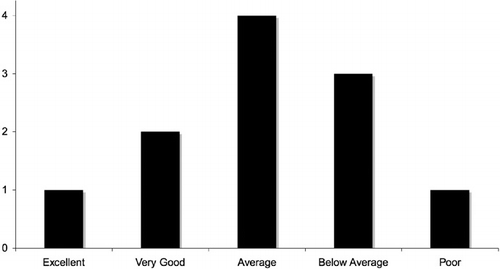
Staff were primarily self or informally trained and it was felt that some specialist training was required in order to optimise eTeaching. Tutors did not resent the extra work required to implement the eLearning environment and the unanimous opinion was that students benefited hugely from a blended approach (mixing seminars and lectures with eLearning).
Conclusions
The evolutionary approach taken to blended teaching and learning through adopting experimental eTeaching and eLearning techniques and technologies allows teaching staff to adapt to changes in the dynamic of a diverse student cohort. Optimising developmental effort in the more successful areas enables the mix of techniques to be adaptive.
The Broadcast Technology courses at Ravensbourne College have been uniquely positioned to evaluate a range of eTeaching and eLearning technologies in an Engineering teaching environment through the College Laptop Project (which has increased laptop ownership to nearly 80%), the diverse nature of its Engineering student intake and the active support and encouragement of the Faculty of Communication Media in exploring new approaches.
Wide-ranging multimedia resources and online submission have enhanced the students’ experience while the use of vodcasted lectures and video tutorials received a less positive response. This may be due to the impersonal nature of the contact compared to that which a relatively small cohort is accustomed to. Such techniques may be more successful with larger student groups. From the tutors’ perspective, the considerable time taken to produce eLearning resources is partly offset by the reduction in administration which results from the use of this technology. However, VLE statistical information streamlines the tracking of student progress and helps to identify students who require extra support.
The eT&L survey results show that students find that the blended learning resulting from using eLearning techniques is a valuable enhancement to their studies. However, this does not necessarily mean that blended learning is the sole learning enhancement for diverse groups in this sector. It is important to evaluate the effectiveness of each approach in order to prioritise development effort and maintain a successful and adaptive blend of eTeaching and eLearning techniques.
Glossary
| Blog (Weblog) | = | A topic-specific interactive website, usually managed by an individual, that combines media (text, images, graphics, videos, audio, music, etc) and links to other blogs and web resources. A blog is often arranged in reverse chronological order and incorporates comments from other users. |
| eLearning (electronic learning) | = | The use of computer-based technology to support and enhance learning. |
| eTeaching (electronic teaching) | = | The use of computer-based technology to support and enhance teaching. |
| Interactive media | = | Any analogue or digital media with which users have an interactive, as opposed to linear, experience. |
| LeaF (learning facilities) | = | Audiovisual equipment that is provided in the main teaching spaces at Ravensbourne College. It comprises a ceiling-mounted projector, multi-region DVD player, VHS player, SMART Board, amplifier, wall-mounted loudspeakers, a desktop PC and laptop connectivity. |
| Moodle (modular object-oriented dynamic learning environment) | = | A free and open-source VLE. The Moodle Company, based in Perth, Australia, oversees development of Moodle. |
| Podcast | = | A collection of audio or video files that is episodically released and can be downloaded by subscribers who use podcatching software to automatically download new episodes when they are released. Despite the term originating from its initial application for broadcasting with iPods, a Podcast can be accessed by any computer that can play media files. |
| Rich media | = | Media content that is interactive and incorporates more that one type of media, for example, video and audio with graphics and images that change with or respond to input from the user. An alternative term used is ‘interactive multimedia.’ |
| SMART board | = | An interactive whiteboard with a touch-sensitive surface that allows control of a computer desktop or presentation when used in conjunction with a projector. |
| VLE (virtual learning environment) | = | An online resource that supports teaching and learning, with tools that allow online submission, assessment, student questionnaires and online tests, feedback and uploading of media resources. Alternative terms used are CMS (course management system) and LMS (learning management system). |
| Vocational | = | In this context, a vocational education or a vocational course prepares the learner for jobs in a specific occupational area, using a practically focused approach to teaching and learning. |
| Vodcast | = | A video podcast. Vodcasts contain video-on-demand video clips delivered online to subscribers via podcatching software. |
| Web video tutorial | = | Using Skype’s video facility and webcams to provide a video link across the internet (or intranet from within the College) as an alternative to a face-to-face tutorial. |
| Web 2.0 | = | An enhanced and more interactive use of the web, allowing users to interact more easily with other users and alter website content. |
| Wiki | = | A collaborative website that uses wiki software to create and edit any number of interlinked webpages. A wiki can be used to organise a group’s information and coordinate its activities. Inspired by Apple’s Hypercard software of the 1980s, wiki means ‘fast’ in Hawaiian. |
References
- BlighD.A. (2000) What’s the use of lectures? San Francisco: Jossey-Bass.
- BrunerJ.S. (1967) On knowing: essays for the left hand. Cambridge, Mass: Harvard University Press.
- ChickeringA.W. and GamsonZ.F. (1987) Seven principles for good practice in undergraduate education. American Association of Higher Education Bulletin, March 1987.
- DavisL.E., HarrisonM.C., PalipanaA.S. and WardJ. P. (2005) Assessment-driven learning of mathematics for Engineering students. International Journal of Electrical Engineering Education, 42 (1), 63-72.
- Engineering Council (2000) Measuring the mathematics problem. London: Engineering Council.
- NakajimaK. (2006) Is “e-Teaching” Web Zero or Potentially Web 2.1? Available from www.cccties.org/access/toukou/nakajima_20061117_2.pdf [accessed 19 October 2009].
- Newman-FordL., LloydS. and ThomasS. (2007) Evaluating the performance of Engineering undergraduates who entered without A-level mathematics via a specialist six-week “bridging technology” programme. Engineering Education: Journal of the Higher Education Academy Engineering Subject Centre, 2 (2), 33-43.
- NortcliffeA.L., FeatherstoneS., GarrickR. and SwiftG. (2003) Supplemental instruction: a higher level learning? In: AungW., HoffmannM., KingR. W., NgW.J. and RuizL. M. S. (eds.) Engineering education and research — 2002: A Chronicle of Worldwide Innovations. Arlington, VA: iNEER.
- SmailesJ. (1998) CALculating success? Available from http://www.icbl.hw.ac.uk/ltdi/evalstudies/essuccess.htm [accessed 19 October 2009].
- YoonS.W. and LimD.H. (2007) Strategic blending: a conceptual framework to improve learning and performance. International Journal on E-Learning, 6 (3), 475-489.

